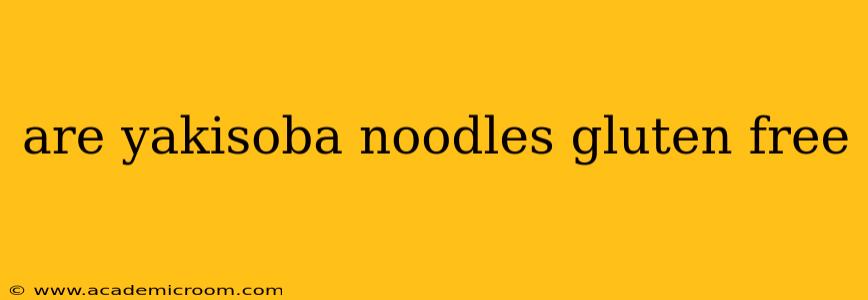Are Yakisoba Noodles Gluten-Free? A Deep Dive into Ingredients and Alternatives
The simple answer to "Are yakisoba noodles gluten-free?" is: no, not typically. Traditional yakisoba noodles are made from wheat flour, making them inherently unsuitable for those following a gluten-free diet. However, understanding the nuances of yakisoba noodles and available alternatives is crucial for making informed choices.
This article will explore the composition of typical yakisoba noodles, delve into common questions surrounding their gluten content, and offer gluten-free alternatives for enjoying this popular Japanese dish.
What are Yakisoba Noodles Made Of?
Yakisoba noodles, a staple in Japanese cuisine, are typically made from wheat flour, water, and sometimes other ingredients like salt and kansui (alkaline mineral water) to give them their characteristic texture and color. This wheat flour base is the primary reason why they're not naturally gluten-free.
Are there gluten-free Yakisoba noodles?
While traditional yakisoba noodles contain gluten, the growing demand for gluten-free options has led to the development of alternatives. You can now find gluten-free yakisoba noodles made from rice flour, buckwheat flour, or blends of other gluten-free flours. These alternatives aim to replicate the taste and texture of traditional yakisoba noodles while catering to dietary restrictions. However, it's crucial to carefully check the ingredient list on any package before purchasing, as even some brands marketed as "gluten-free" might contain trace amounts of gluten due to cross-contamination during processing.
Can I make gluten-free yakisoba noodles at home?
Yes! Making your own gluten-free yakisoba noodles at home offers complete control over ingredients and guarantees a gluten-free product. Numerous recipes are available online using various gluten-free flour blends. Experimenting with different flour combinations will allow you to find the perfect texture and taste that suits your preferences.
What are some good gluten-free alternatives to yakisoba noodles?
If you can't find gluten-free yakisoba noodles or prefer to make your own, several excellent alternatives offer a similar culinary experience:
- Rice noodles: These offer a neutral flavor and a slightly softer texture compared to wheat-based yakisoba.
- Shirataki noodles: These noodles, made from konjac yam, are very low in calories and carbohydrates, providing a unique textural experience. They absorb flavors well but have a somewhat rubbery texture.
- Kelp noodles: These are made from seaweed and are naturally gluten-free, low in calories and carbs. They have a slightly chewy texture.
- Zucchini noodles (zoodles): These are a great low-carb option, but their texture differs significantly from traditional yakisoba noodles.
Remember to check the ingredient list of any sauce or seasoning you use with your gluten-free yakisoba to ensure they also comply with your dietary requirements.
Do all Yakisoba noodle brands contain gluten?
No, not all brands contain gluten. As mentioned earlier, some companies now produce gluten-free yakisoba noodles using alternative flours. However, always check the label and confirm that it specifically states "gluten-free" to avoid accidental gluten ingestion.
Are there any hidden sources of gluten in Yakisoba?
While the noodles themselves are the primary source of gluten, cross-contamination during processing or the presence of gluten in sauces or seasonings used in the preparation of yakisoba can be a concern. Always check labels thoroughly and opt for brands and products specifically labeled "gluten-free" to minimize this risk.
By understanding the ingredients and available alternatives, you can enjoy a delicious and satisfying yakisoba meal while adhering to your gluten-free diet. Careful label reading and informed choices are key to ensuring a safe and enjoyable culinary experience.
